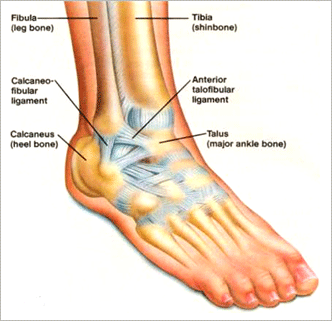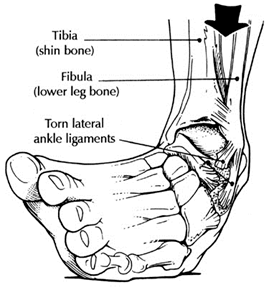Ankle sprains are very common and happen when an unnatural movement (such as a roll, twist or turn) occurs, which can stretch or tear the ligaments that help hold the ankle together.
You should always seek medical attention with a sprained ankle so the severity of the sprain can be assessed and a proper treatment plan can be put in place.
Something that our doctors will recommend to many of their ankle sprain patients is at-home exercises, which will help speed up the recovery process and re-build the strength needed in the ankle. There are three main reasons why exercises are crucial for patients to perform:
- It's imperative to restore to normal what's known as "range of motion"
- Strength must be rebuilt so a repeat injury isn't more likely to occur
- The nerves, muscles and ligaments in the ankle need to be retrained to respond to the body's different movements
Often some gentle range of motion exercises are recommended. These can include "writing" the alphabet with the big toe. An active ankle brace or other ankle brace while doing this exercise may help reduce swelling and pain. Keeping an ice pack on the ankle while doing this exercise is also helpful.
After a few days of "writing" the alphabet, you may be able to move on to other stretches, such as the towel stretch. Fold a towel lengthwise and position it around your forefoot. Gently flex your foot upward. These types of exercises should only be performed if directed by a doctor to do so. Otherwise more damage to the ankle may occur if the sprained ankle is misdiagnosed.
Please keep in mind that before starting these exercises, you need to be evaluated by a doctor to determine if these exercises are right for you.
Ankle sprains are one of the most common injuries we see at Issaquah Foot & Ankle Specialists. They are also one of the most under treated injuries in medicine. Patients often do not seek treatment or do not follow up after the initial visit which often takes place in the emergency room. This can have devastating consequences for the long term function of the ankle. Ankle sprains can injury the following structures:
- Ligaments
- Tendons
- Cartilage
- Bone

The above picture demonstrates the lateral ligament complex of the ankle. You can see the anterior talofibular ligament which is the most common ligament injured following an ankle sprain. The calcaneofibular can be injured as well, however this is less common. Ligaments can take 6-8 weeks to completely heal if a tear does occur. It is essential to seek medical treatment from a foot and ankle specialist. They will guide you in rehabilitation to allow adequate time for ligaments to heal and appropriate strengthening exercise to speed recovery.
Repeated ankle injury can lead to Chronic Ankle Instability or Chronic Ankle Sprains
 Chronic ankle instability is the recurring “rolling” or “giving away” of the outer side of the ankle. The ligaments on the lateral side of the ankle may become weakened over time and after repeated ankle sprains. Typically the “rolling” or “giving away” occurs when walking or being active. This is a common occurrence with athletes. However, this can even happen when simply standing.
Chronic ankle instability is the recurring “rolling” or “giving away” of the outer side of the ankle. The ligaments on the lateral side of the ankle may become weakened over time and after repeated ankle sprains. Typically the “rolling” or “giving away” occurs when walking or being active. This is a common occurrence with athletes. However, this can even happen when simply standing.
Symptoms:
Symptoms of chronic ankle instability may include pain, swelling or tenderness of the area. The most obvious symptom is the frequent rolling or turning of the ankle.
Causes:
Chronic ankle instability is generally caused by an ankle sprain that has not healed completely. When the ankle is sprained the ligaments are damaged. These ligaments, depending on the severity of the injury, are either stretched or torn. The image on the top right shows these ligaments as being wavy. This is how the ligaments appear after being stretched as a result of an ankle sprain. These stretched ligaments can lead to chronic ankle instability if they are not properly healed.
Diagnosis:
If you experience frequent ankle sprains or chronic instability in your ankles you should have this evaluated by us. If this condition is left untreated it can lead to further complications. The instability can lead to injuries as a result of a fall and arthritis and tendon problems. Depending on your circumstances an x-ray, CT scan, or MRI may be ordered to determine the best course of action.
Treatment:
Based on the examination results surgery may or may not be necessary. Nonsurgical treatments include physical therapy to rehabilitate and strengthen the muscles. Bracing can be effective by offering support to the ankle and prevent abnormal movement. Nonsteroidal anti-inflammatory drugs like ibuprofen can reduce swelling and pain. If the problem is severe surgery may be necessary. If the instability is significant and non-surgical methods do correct the issue reconstructive surgery to repair the ligaments will correct this issue.
Other common causes of ankle pain
There are many reasons for ankle pain; some of the most common include a history of ankle sprains or trauma. Trauma or sprains can often result in inflammation of the ankle joint or damage to soft tissue structures like ankle ligaments or tendons. The anterior talar fibular ligament or peroneal tendons are often injured with sprains.
Patients often relate a stiffness, popping or catching of the ankle as part of these symptoms. These can be attributed to other causes including arthritis of the ankle or damage to cartilaginous surfaces.
There are a variety of treatment options from conservation care to surgical reconstruction.



